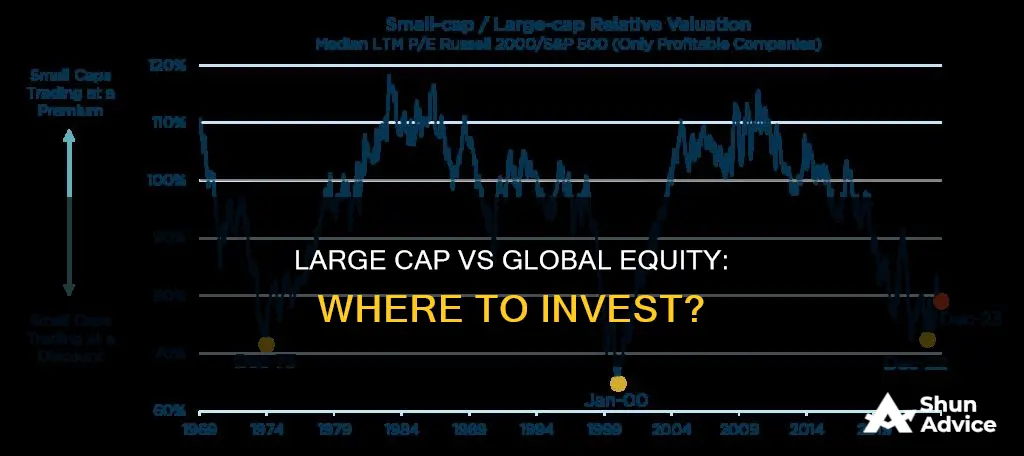
Global large-cap and global equity are both compelling investment options, each with distinct advantages and considerations. Global large-cap stocks refer to shares of companies with a market capitalization typically exceeding $10 billion. These companies, often well-established and transparent, are usually less volatile and tend to be core holdings in investment portfolios due to their stability and dividend payouts. On the other hand, global equity investing offers expanded opportunities, providing access to higher growth rates in emerging and frontier economies outside the US. The decision to invest in global large-cap or explore global equity options depends on various factors, including investment goals, time horizons, and risk tolerance. While global large-cap stocks offer stability, global equity investing taps into the growth potential of diverse markets, enhancing portfolio diversification and enabling investors to capitalize on economic trends beyond the US borders.
What You'll Learn

Large-cap stocks are generally safer investments
Large-cap companies are often at the peak of their business cycle, with established and stable revenue and earnings. They are also more likely to pay dividends to shareholders. These factors make large-cap stocks a common choice for investors seeking income through conservative investing.
The size and tenure of large-cap companies provide stability, making them less likely to encounter economic circumstances that could force them to stop operations. This stability also means that large-cap stocks are less risky and more resilient during rough markets or economic downturns. They are also more liquid, with higher trading volumes, and have greater access to capital and financial resources.
Large-cap stocks are often used as core portfolio holdings due to their perceived safety and the advantages outlined above. However, it is important to note that large-cap stocks may offer lower growth prospects compared to smaller companies and may not be as nimble in adapting to changing market conditions. Therefore, investors should consider a mix of large-cap, mid-cap, and small-cap stocks to balance their portfolio and maximise returns.
SIP Investment: A Smart Way to Invest in India
You may want to see also

Large-cap companies are more established
Large-cap companies have a broader market issuance experience and greater access to capital. They have a more diversified business and global footprint, which helps reduce the risk of failure. Their size and established presence provide a buffer if the economy slows down in a particular region and expose them to fluctuations in the currency market.
Large-cap stocks are also less prone to wild swings in stock prices and are therefore less risky. They are considered core portfolio investments and often included in major stock market benchmarks, such as the S&P 500 and the Dow Jones Industrial Average.
While large-cap companies offer stability and dividends, they may not provide the same growth opportunities as smaller companies. They may offer fewer growth prospects as they are already dominant in their respective industries and have a more established market share.
In summary, large-cap companies are more established, providing investors with a safer, more stable, and less volatile option. They are often transparent, dividend-paying, and market-leading businesses with a global reach.
Understanding Investment Strategies: Model Portfolios Explained
You may want to see also

Large-cap stocks are less volatile during rough markets
Large-cap stocks are shares issued by mature, well-known companies with a market capitalisation of over $10 billion. These companies are often transparent, stable, and impactful, making them less volatile during rough markets.
Large-cap companies are typically transparent, making it easy for investors to find and analyse public information about them. This transparency allows investors to make more informed decisions about their investments and can lead to greater stability in the stock price.
Large-cap companies are also often stable and established, with consistent dividend payments and steady growth. They are usually dominant players in their industries and have familiar brand names. This stability makes them less volatile during rough markets as investors seek out quality and stability.
Additionally, large-cap companies tend to have more diversified business structures, which can lead to more stable business performance and less variable earnings and revenue streams. They also tend to be less sensitive to economic headwinds, further contributing to their lower volatility during rough markets.
Overall, large-cap stocks are less volatile during rough markets due to their transparency, stability, diversification, and established track records. These factors make them attractive investments for those seeking lower-risk options.
India's Investment in Chabahar: Exploring Strategic Interests
You may want to see also

Large-cap stocks are more transparent
Large-cap stocks are shares in corporations with a market capitalization of $10 billion or more. They are known for their transparency, making it easy for investors to find and analyze public information about them. This transparency is a key advantage for investors considering large-cap stocks. Here are some reasons why large-cap stocks are considered more transparent:
- Public Information Availability: Large-cap companies are typically well-known, established businesses that regularly disclose financial information to the public. This includes publishing financial reports, allowing investors to assess their performance and make informed investment decisions.
- Analyst and Media Coverage: Large-cap firms are extensively covered by analysts and the financial media. This comprehensive coverage provides investors with a wealth of information, enabling them to conduct in-depth research and analysis before investing.
- Track Record and Data Availability: Large-cap companies have often been in business for a longer period, providing investors with more historical data on their operations, financial activities, and decision-making. This extensive track record allows for a more informed assessment of their stability and future prospects.
- Regulatory Compliance: Large-cap companies, due to their size and market presence, are subject to stricter regulatory requirements. They are typically listed on major stock exchanges, adhering to higher standards of transparency and disclosure, which further enhances their transparency.
- Investor Relations: Large-cap companies often have dedicated investor relations teams or departments. These teams provide detailed information to current and potential investors, making it easier for investors to obtain answers to their queries and gain insights into the company's strategies and performance.
The transparency of large-cap stocks is a significant factor in their attractiveness to investors. It allows investors to make more informed decisions, assess risks effectively, and have greater confidence in the stability and performance of these companies.
Equity-Indexed Annuities: Unlocking Investment Opportunities
You may want to see also

Large-cap stocks are dividend payers
Large-cap stocks are shares in corporations with a market capitalization of $10 billion or more. They are typically transparent, stable, and established companies that are leaders in their markets. These stocks are often chosen by investors for dividend income distributions due to their ability to offer high dividend payout ratios.
Large-cap companies are usually at the peak of their business cycle, generating stable revenue and earnings. Their size and maturity make them less volatile during rough markets, as investors seek out quality and stability. Large-cap stocks are also more liquid and have greater trading volumes than their smaller counterparts. They are often core portfolio holdings, constituting a significant portion of the US equity market.
Large-cap stocks are known for their transparency, making it easier for investors to access and analyze public information about the company. This accessibility contributes to their popularity among investors seeking dividend income. The stability and maturity of large-cap companies enable them to establish and maintain high dividend payout ratios.
Additionally, large-cap companies are often market leaders that produce innovative solutions and have global market operations. Their market news is typically impactful on the broad market overall. These companies tend to be blue-chip organizations with established revenue streams and earnings, which makes them attractive for investors seeking dividend income distributions.
Overall, large-cap stocks are attractive to investors seeking dividend income due to their stability, transparency, and market leadership. Their mature establishment and high dividend payout ratios make them a reliable choice for those looking to generate dividend income through their investments.
Global Infrastructure Management LLC: A Smart Investment Strategy
You may want to see also
Frequently asked questions
Large-cap stocks are shares in companies with a market capitalization of $10 billion or more. They are generally safer investments than mid-cap or small-cap stocks because the companies are more established.
A global fund is a mutual fund or ETF that invests in companies located anywhere in the world, including the investor's own country. Global funds seek to identify the best investments from a global universe of securities.
Large-cap stocks are generally safer and less volatile investments than their smaller counterparts because the companies are more established and less prone to wild swings in stock prices. They are also typically more transparent, making it easier for investors to find and analyse public information about them.
Global funds provide investors with a diversified portfolio of global investments, which can increase an investor's potential returns. They also help to mitigate some of the risks associated with international investments.
Global large-cap funds invest in large-cap stocks, which are shares in well-established companies with a market capitalization of $10 billion or more. These stocks are generally considered safer and less volatile than small-cap or mid-cap stocks. Global equity funds, on the other hand, invest in a broader range of stocks, including small-cap and mid-cap stocks, which may offer higher returns but also carry more risk.







